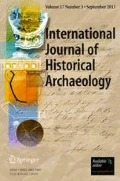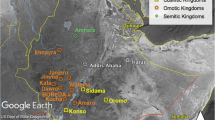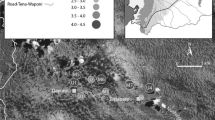Abstract
In recent years there is a growing interest in the “Sacred Forests” (vakoúfika) of Zagori in Northwest Greece. These are either groves or individual trees, dedicated to patron saints, protected through customary laws, communal regulations, religious excommunications, and supernatural narratives. For ca. 300 years they have represented the tangible reminders of rituals, beliefs, and pre-modern ways of managing the commons to an extent that they survive in the present. This article introduces archaeology into the interdisciplinary discourse revolving around vakoúfika. Through the concepts of dwelling, walking, and archaeological ethnography, I evaluate the concept of static “traditional” mountainous communities and focus on the changes that might have occurred to the rituals and beliefs associated with vakoúfika over the past centuries. The case study is the Sacred Forest of Băeasă (Vovousa), dedicated to St. Viniri and the associated rituals. In situ observations and especially the exploration of the role of two stones in the celebration reveal an archaeological layer to the pilgrim, in which the center of the ritual was the forest not its associated chapel.

© Faidon Moudopoulos-Athanasiou

© Kalliopi Stara

© George Detsis

© Faidon Moudopoulos-Athanasiou

© George Detsis


© Faidon Moudopoulos-Athanasiou

© Maria Nolla/Amaryllis Louverdi

© Faidon Moudopoulos-Athanasiou

© Faidon Moudopoulos-Athanasiou

© Faidon Moudopoulos-Athanasiou


© Faidon Moudopoulos-Athanasiou
Similar content being viewed by others
References
Barrett, J. C. (1988). Fields of discourse: reconstituting a social archaeology. Critique of Anthropology 7(3): 5-16.
Barrett, J. C. (1994). Fragments from Antiquity: An Archaeology of Social Life in Britain, 2900-1200 BC. Blackwell, Oxford.
Benedetti, Y., Kapsalis, E., Morelli, F., and Kati, V. (2021). Sacred oak woods increase bird diversity and specialization: links with the European Biodiversity Strategy for 2030. Journal of Environmental Management 294: 112982.
Chang, H. (2016). Autoethnography as Method, Volume 1. Routledge, London.
Chouliaras, I. (2009). Η Eντοίχια Θρησκευτική Ζωγραφική του 16ου και 17ου Αιώνα στο Δυτικό Ζαγόρι, Rizareios Ecclesial School, Athens.
Clayer, N. (2016). Religious pluralism in the Balkans during the late Ottoman imperial era: towards a dynamic model. In Murphey, R. (ed.), Imperial Lineages and Legacies in the Eastern Mediterranean. Routledge, New York, pp. 101-114.
Dalkavoukis, V. (2011a). Γράφοντας Aνάμεσα. Εθνογραφικές Δοκιμές με Αφορμή το Ζαγόρι. Thessaloniki: Epikentro.
Dalkavoukis, V. (2011b). From ethnic to ethno-local identity: the example of the Sarakatsani at Zagori (Epirus) in 20th century. In Nitsiakos, V., Manos, I., Agelopoulos, I., Angelidou, A., and Dalkavoukis, V. (eds.), Balkan Border Crossings, Second Annual of the Konitsa Summer School. LIT Verlag, Berlin, pp. 31-46.
Dalkavoukis, V. (1999). Μετοικεσίες Ζαγορισίων 1750-1922. Rizareios Ecclesial School, Athens.
De Rapper, G. (2012). The Vakëf: sharing religious space in Albania. In Albera, D. and Couroucli, M. (eds.), Sharing Sacred Spaces in the Mediterranean. Indiana University Press, Bloomington, pp. 29-51.
Drougias, Th. (1995). Η Βωβούσα στο χώρο και το χρόνο. Ioannina.
Eliot, T. S. (1936). Burnt norton. Collected Poems 1909–1935. Harcourt, Brace, New York.
Forbes, H. (2007). Meaning and Identity in a Greek Landscape: An Archaeological Ethnography. Cambridge University Press, Cambridge.
Filidou, A. (2020). Η ζωγραφική των φορητών εικόνων στην περιοχή του Ζαγορίου της Ηπείρου 15ος-17ος αιώνας. Doctoral dissertation, University of Athens, Athens.
Gounaris, B. (1997). Vlachs and "their own" history. Études Balkaniques 3: 75-84.
Greene, M. (2021). History in high places: Tatarna Monastery and the Pindus mountains. Journal of the Economic and Social History of the Orient 64(1-2): 1-24.
Grehan, J. (2016). Twilight of the Saints: Everyday Religion in Ottoman Syria and Palestine. Oxford University Press, Oxford.
Hamilakis, Y. (2021). From fields of discourse to fields of sensoriality: rethinking the archaeological record. In Boyd, M. and Doonan, R. (eds.), Far from Equilibrium: An Archaeology of Energy, Life and Humanity: A Response to the Archaeology of John C. Barrett. Oxbow, Oxford, pp. 239-257.
Hamilakis, Y. (2014). Archaeology and the Senses: Human Experience, Memory, and Affect, Cambridge University Press, Cambridge.
Hamilakis, Y. and Anagnostopoulos, A. (2009). What is archaeological ethnography? Public Archaeology 8(2-3): 65-87.
Herzfeld, M. (2020). Ours once more: Folklore, ideology, and the making of Modern Greece. Rev. ed. Berghahn, New York.
Ingold, T. (1993). The temporality of the landscape. World Archaeology 25(2): 152-174.
Kahl, T. (2003). Aromanians in Greece: minority or Vlach-speaking Greeks?. History and Culture of Southeastern Europe 5: 205-219.
Karavidis, Ch. (2013). Τραγούδια και χοροί της Βωβούσας. Bachelor's thesis, TEI of Epirus, Arta.
Koltsidas, A. (1997). Ιστορία της Βωβούσας. Αφοί Κυριακίδη, Θεσσαλονίκη.
Lambridis, I. (1870). Ζαγοριακά A’ Athens.
Marini Govigli, V., Efthymiou, A., and Stara, K. (2021). From religion to conservation: unfolding 300 years of collective action in a Greek sacred forest. Forest Policy and Economics 131: 102575.
Marini Govigli, V., Healey, J. R., Wong, J. L., Stara, K., Tsiakiris, R., and Halley, J. M. (2020). When nature meets the divine: effect of prohibition regimes on the structure and tree species composition of sacred forests in northern Greece. Web Ecology 20(2): 53-86.
McNeill, J. R. (2003). The Mountains of the Mediterranean World. Cambridge University Press, Cambridge.
Messini, K. (2019). St. Viniri – the Sacred Forest. DTV production.
Moudopoulos-Athanasiou, F. and Sklavounos, I. (2022). Walking the kalderimi: embodied knowledge and heritage narratives in a participatory building workshop at Zagori (NW Greece). In Svensson, D., Saltzman, K., and Sörlin, S. (eds.), Pathways: Exploring the Routes of a Movement Heritage. White Horse Press, Cambridge.
Moudopoulos-Athanasiou, F. (2022). The Early-Modern Zagorochoria (NW Greece): An interdisciplinary archaeological inquiry into a Montane Cultural Landscape. Sidestone Press, Leiden.
Moudopoulos-Athanasiou, F. (2020a). Woodland values in Zagori, NW Greece (19th–21st Century): between heritage and history. PLURAL 8(2): 103-119.
Moudopoulos-Athanasiou, F. (2020b). The ruins of others: cases from the Ottoman heritage of Konitsa (NW Greece). Journal of Modern Greek Studies 38(2): 371-397.
Nitsiakos, V. (1997). Λαογραφικά Ετερόκλητα. Οδυσσέας, Αθήνα.
Nitsiakos, V. (2016). Peklari: Social Economy in a Greek Village. LIT Verlag, Münster.
Saralis, Y. (1957). Ζαγόρι - Ένας Απίθανος Κόσμος. Αθήνα.
Saratsi, E. (2005). The cultural history of "kladera" in the Zagori area of Pindos Mountain, NW Greece. News of Forest History 36/37 (1): 107–117.
Seirinidou, V. (2014). Δάση στον ελληνικό χώρο (15ος–18ος αι.): Αναψηλαφώντας μια ιστορία καταστροφής. Μεσαιωνικά και Νέα Ελληνικά 11: 69–87.
Stara, K., and Tsiakiris, R. (2019). Oriental planes platanus orientalis L. and other monumental trees in central squares and churchyards in NW Greece: sacred, emblematic and threatened. Acta Horticulturae et Regiotecturae 22(1):14–18.
Stara, K., Tsiakiris, R., Nitsiakos, V., and Halley, J. M. (2016). Religion and the management of the commons: the sacred forests of Epirus. In Angoletti, M. and Emanueli, F. (eds.), Biocultural Diversity in Europe. Springer, New York, pp. 283–302.
Stara, K., Tsiakiris, R., and Wong, J. L. (2015). Valuing trees in a changing cultural landscape: a case study from northwestern Greece. Human Ecology 43(1): 153-167.
Stara, K. (2009). Μελέτη και καταγραφή ιερών δασών και δασυλλίων στον Εθνικό Δρυμό Βίκου-Αώου: παραδοσιακές μορφές διαχείρισης, αντιλήψεις και αξίες των τοπικών κοινωνιών για τη διατήρηση του φυσικού τους περιβάλλοντος. Doctoral dissertation, University of Ioannina, Ioannina.
Tatay, J. (2021). Sacred trees, mystic caves, holy wells: devotional titles in Spanish rural sanctuaries. Religions 12(3), 183.
Tsampouras, T. (2013). Τα καλλιτεχνικά εργαστήρια από την περιοχή του Γράμμου κατά το 16ο και 17ο αιώνα. Doctoral dissertation.Aristotle University of Thessaloniki, Thessaloniki.
Tomaz, C., Alegria, C., Monteiro, J. M., and Teixeira, M. C. (2013). Land cover change and afforestation of marginal and abandoned agricultural land: a 10 year analysis in a Mediterranean region. Forest Ecology and Management 308: 40-49.
Urry, J. (2002). The Tourist Gaze. Sage, Thousand Oaks, CA.
Vionis, A. K. (2022). The construction of sacred landscapes and maritime identities in the post-Medieval Cyclades islands: the case of Paros. Religions 13(2): 164.
Vrazitoulis, G. (2017). Βλάχοι εκτοπισμένοι στον πόλεμο του ‘40. Ηπειρωτικός Αγών, January 17.
Acknowledgments
An earlier version of this research was presented at Pilgrim CHAT, 2021, and I am grateful for the feedback I received on that occasion. My experience at the Vovousa Festival has facilitated my research in multiple ways and for this reason, I thank the director, Kamilo Nollas. After finishing my PhD at the University of Sheffield and before moving out of town at a time the university bureaucrats decided to shaft the department of archaeology, I found the writing of this article a decent escape from the neoliberal university reality and the advice of Paul Halstead and John Barrett in coffee shops around Nether Edge inspiring. I thank them for being there. Finally, I wish to express my gratitude George Detsis and Kalliopi Stara for providing me with the necessary visuals for this article and Maria and Amaryllis for creating the subjective map of figure 8.
Author information
Authors and Affiliations
Additional information
Publisher's Note
Springer Nature remains neutral with regard to jurisdictional claims in published maps and institutional affiliations.
Supplementary Information
Below is the link to the electronic supplementary material.
Rights and permissions
About this article
Cite this article
Moudopoulos-Athanasiou, F. The Celebration of St. Viniri in Băeasă (Vovousa): Approaching the Archaeology of the Sacred Forests in Northwest Greece. Int J Histor Archaeol 27, 575–597 (2023). https://doi.org/10.1007/s10761-022-00664-5
Accepted:
Published:
Issue Date:
DOI: https://doi.org/10.1007/s10761-022-00664-5




